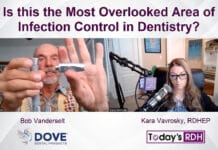In an ideal world, the relationship between the dental hygienist and the dentist is one that is in sync and well-calibrated. If the dental hygienist and dentist can truly rely on one another, it allows for seamless and successful diagnosis and treatment planning, and patients will better understand treatment recommendations.
The dental hygienist and dentist can help to influence successful co-diagnosis in many ways. In order to do that well, though, three simple key factors need to be remembered ‒ trust, timing, and tools.
1) The Trust
In my experience, the most influential element that contributes to successful treatment acceptance is trust. It is evident that patients often will have greater trust in their hygienist over that of the doctor. It may be related to the dental hygienist having the opportunity to spend more time with each patient or the fact that most dental hygienists have connected well enough with their patients to know personal details about them. Whatever the reason may be, it allows a baseline of trust between the dental hygienist and the patient.
It is essential to align the treatment philosophy between the dental hygienist and dentist. The dental hygienist should be well-calibrated in order to confidently recognize the way in which the doctor typically recommends treatment. The hygienist may be able to recognize a case where the doctor would recommend a crown over a filling and be able to explain the doctor’s rationale to the patient. This is crucial since, after the doctor’s exam, the patient likely will turn to the dental hygienist and say, “Mandy, do you think that I really need that crown?”
Therefore, it is beneficial to ensure that each dental hygienist has the confidence to reinforce the doctor’s recommendations. By reiterating the treatment that is being recommended, the dental hygienist has increased the likelihood of patient treatment acceptance.
Understanding that there is a foundation of trust is fundamental for the dental hygienist and patient relationship. This can help guide the dental hygienist to discuss potential treatment needs with each patient during their hygiene appointment. This conversation can take place prior to the dentist’s exam.
For this to work well, the dental hygienist and dentist must be committed to understanding one another precisely. It is beneficial that the dental hygienist learns and understands the philosophy of their doctor, as well as the way he or she typically recommends treatment. The dental hygienist should work towards increasing the trust a patient has in the doctor’s recommendations.
This can be done in two ways:
1) The dental hygienist simply informs the patient about possible treatment needs.
“Patient A, you see this dark spot on your molar? That is likely an area Dr. B will evaluate during your exam today. Dr. B will evaluate this area during your exam, but I like to let you know ahead of time of the areas that appear to possibly be a concern.”
2) The dental hygienist more confidently informs the patient about his/her treatment needs. “Patient C, you’ve been missing your upper canine tooth for one year now. The bone is healthy, and Dr. D is specially trained to place implants. I’d be happy to take your CT scan and schedule your implant consult to get that treatment started for you!”
The dental hygienist uses this communication with patients to validate the doctor’s treatment recommendations. There is also value in the patient hearing treatment needs multiple times, both from the hygienist and doctor, to increase a patient’s understanding.
2) The Timing
The communication that prefaces the doctor’s exam can determine whether or not the patient understands and agrees to the recommended treatment. If the dental hygienist can make the patient aware of a potential problem area, then the doctor is simply confirming the treatment that has already been mentioned.
The hygienist has planted the seed. This works well because the doctor will be reiterating what the dental hygienist has mentioned as opposed to the dentist coming in for the exam and informing the patient about needed treatment shortly before the end of their appointment.
The dental hygienist has the ability to guide the dental exam based on a patient’s chief complaint(s) and any other concerns that have been discovered during the hygiene appointment.
It could go like this;
“Dr. E, I’ll give you a moment to review Patient F’s radiographs, but, while you’re doing that, you’ll notice a large fracture on #20; I talked to Patient F about it and let her know that, due to size of the fracture, you may consider placing a crown on the tooth. Please let myself and Patient F know what you feel is the best treatment.”
The doctor may even respond with the lesser treatment option, such as, “Thank you, Mandy, for completing such thorough radiographs. Upon taking a closer look at the tooth, I feel I can conservatively treat the tooth with a large filling. Please schedule her for a MOD on #20.”
In cases where the doctor opts for the more conservative treatment, it provides some reprieve to the patient. The hygienist has provided the possibilities of treatment, but ultimately the patient will likely be relieved to hear that they are receiving care from a doctor that is both thorough and conservative. The hygienist has another opportunity to reiterate and validate the treatment recommendations being made.
3) The Tools
The dialogue between the dental hygienist, doctor, and the patient is highly important. As the saying goes, though, “Seeing is believing.”
The use of appropriate equipment can further assist the dental hygienist in explaining possible treatment recommendations to the patient. The use of an intraoral camera is just the type of technology that will help the patient visually see an area of concern. Perhaps that means a full series of intraoral photos is completed at each new patient appointment in conjunction with the necessary radiographs.
It is very difficult for most patients to comprehend or see what a dental professional may show them on a radiograph. I’ve had countless patients tell me that the radiographs of their teeth look like toes! It really puts into perspective a patient’s inability to understand the anatomy that is being shared with them via a radiograph. While using a radiograph in cases of obvious dark decay, broken teeth, and abscess infections may be more easily understood by a patient, any diagnosis that has an intraoral photo and an x-ray is likely to be better understood by the patient.
Taking a clear intraoral photo in conjunction with the x-ray is a way to ensure a patient can see what we see. Instead of simply saying to the patient, “You need a filling because I can see there is a dark spot on the tooth,” the use of an intraoral camera allows you to say, “Take a look at this photo I took of your back molar. Do you see that brown spot on the grooves of your tooth? That is the cavity Dr. H mentioned to you, and she will need to remove the decay and place a filling.”
The conversation is a lot smoother and easier when the patient can view their diagnosis.
After working alongside many doctors with high expectations, I have made it my mission to have these three things ready for the doctor once they enter the room for the hygiene exam:
- Radiograph image
- Intraoral image
- Informed patient about areas of concern and shared the images with the patient.
A great way to guide the doctor’s exam is to have the x-ray and intra-oral image on display for both doctor and patient as the dental exam begins. Every minute counts when it comes to the hygiene appointment, but if the dental hygienists do have the opportunity to prep the doctor in reference to the conversation that has been discussed with the patient, that can be a huge advantage.
This can be done two ways, depending on the amount of time available:
Before the doctor enters the room: Prepping your doctor before they enter for the exam is great for patients who have major anxieties or appear to be hesitant about their oral health needs. You can cue your doctor about personal, financial, or any other contributing information that helps the doctor deliver the message in a way that is appropriate for the patient.
It is imperative to guarantee individualized treatment for every single patient who sits in your chair. That means telling a 25-year-old patient about their periodontal needs could sound completely different than telling a 56-year-old patient that they need the same treatment.
Telling the doctor important and personal information before the exam could go like this: “Hey, Doc, so Patient J is fully aware that she needs an implant to replace tooth #30 but she is hesitant because she just lost her husband unexpectedly and has financial concerns.”
These personal reasons are bits of information to share with the doctor without having to repeat sensitive information in front of the patient. It also means that the doctor can deliver the message in a way that is sensitive to the patient’s current situation while still creating emphasis on her oral health needs.
While the doctor is in the room: The more efficient and more frequent option can be done as the doctor enters the room: “Hey, Dr. K, I was just discussing with Patient L that an implant would be the most optimal way to replace her missing tooth. She understands an implant is ideal but would like to review the financial commitment with her daughter. She’d prefer that we touch base with her in two weeks.”
A hand-off such as this will indicate to the doctor that the dental hygienist may have good reason to make a suggestion of touching base with her at another time and can guide the doctor on how to proceed with his/her exam as it relates to presenting the treatment to the patient.
In Closing
It is incredibly beneficial when a dental hygienist and dentist are able to be in sync and trust each other’s work. When calibrated, the relationship between a dental hygienist and dentist can truly allow for seamless and successful diagnosis, treatment planning, and patients who understand the treatment recommendations.
Before you leave, check out the Today’s RDH self-study CE courses. All courses are peer-reviewed and non-sponsored to focus solely on high-quality education. Click here now.
















